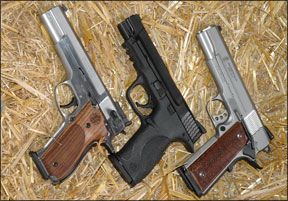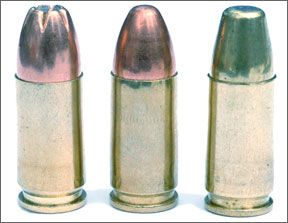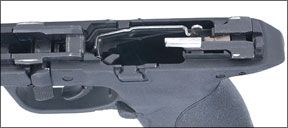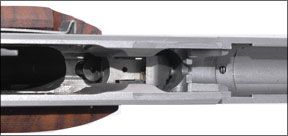In this test we have a diverse trio of pistols that offer a wide look at some of what’s available in the world of Smith & Wesson’s full-size 9mm handguns. We acquired a striker-fired M&P 9 Pro Series with fiber optic front sight (No. 178010, $830). Next up was a 9mm 1911-type pistol in the SW1911 Pro Series (No. 178017, $1683). Last, we assessed the Performance Center-built Model 952 (No. 170244, $2402), which is essentially a remake of the old 38-Special-only Model 52, but for 9mm ammunition.

All three of these guns felt considerably different in the hand, as though they were made on totally different planets. They were all set up to some extent for self defense. Even the 952 had a relieved magazine well for fast reloads. The M&P9 held 17+1 rounds, the SW1911 held 10+1, and the 952 held 9+1 rounds. The weights of these guns were also quite different, the heaviest being the 1911, which also had thick grip panels that we found to be a touch on the over-filling side.
We tested the trio with Fiocchi 115-grain JHP, Black Hills 147 FMJ, and with Winchester BEB 115-grain truncated-cone ammo. We evaluated the three guns for self-defensive use, and also for potential target shooting, particularly the 952. Here’s what we found.
S&W M&P9 Pro Series 9mm No. 178010, $830
This serious pistol was all matte-black stainless steel and plastic, with a huge 18-round maximum ammo capacity. The M&P sat low in the hand much like a target pistol, and its trigger—the only obvious safety on the gun—fell to the finger easily and with great comfort. The shape of the grip may be changed by swapping the insert of the rear strap, so to some extent you can tailor the grip to your hand. The trigger pull on our test gun broke nicely at 5.5 pounds. There was a rail under the muzzle for a light, and the front sight was a bright-green fiber-optic insert.
The sight picture was fairly normal in silhouette, with a flat top to the front sight and adequate room on its sides to give an excellent sight picture. With any light falling onto the front blade, the green insert gave the shooter a glowing green dot for the front sight, making for easier hits in questionable light. However, the front dot does not glow in the dark, like tritium sights. In a dark alley the sights may not be visible. The gun had ambidextrous slide-stop levers, not often seen and mighty useful for lefties. The frame had a storage lock to prevent the gun from firing in the wrong hands.
Takedown was very easy, more so than on either of the other two test guns. Be sure the gun is empty and remove the magazine before taking off the slide. With the slide locked back, rotate the takedown lever 90 degrees and carefully release the slide forward. Press the trigger to uncock the striker, and off comes the slide. With the slide off, the color-coded spring can be pulled downward and out, and then the long barrel comes out for breech cleaning. Reassembly is a simple reverse of the process. Field stripping the M&P is a demonstration of exactly how well this process can be designed by a clever gunmaker. It takes only a few seconds to get the gun completely apart for cleaning. There are no small parts to be lost. With the barrel and innards cleaned, it takes just seconds to put the gun back together again. Stick in the barrel and spring, slip the barrel assembly onto the slide and pull the slide quickly to the rear. The takedown lever snaps back to the fully assembled position all by itself. If you have an M&P, there’s no excuse for having it dirty. With very little practice we were able to field strip it completely in seven seconds, and reassemble it in ten.

On the range we found the magazine easy enough to load, and the gun worked just as it was designed to operate. The gun will fire with the magazine out, as will the SW1911. The 952 won’t. There were no problems, and the gun shot very well, but we noted one characteristic common to some autoloaders, the “first-shot syndrome.” That the first one out of the gun would land in Wisconsin while the rest of the shots hit somewhere in Texas. The discrepancies were not really measured in miles, but here’s a couple examples: group size, five shots, 3.7 inches. The second four landed inside an inch. Different ammo, five went into 3.0 inches, with the second four in 0.9 inch. We didn’t see any signs of this going away, but it might with added shooting and with just the right ammo. The gun wanted to shoot, as many of its groups had three shots touching. But of course we reported the full group sizes. The worst five-shot group was the one mentioned above, 3.7 inches at 15 yards.
Our Team Said: We found the M&P9 could shoot very fast and with more than adequate accuracy. Even our 1911-lover was impressed by the possibilities of this efficient and relatively light pistol. This is the second M&P9 we’ve shot here in Idaho, and we can tell you if we wanted a personal 9mm pistol for self defense, we’d most likely get one of these M&Ps. This one gets an A-, the minus for the less-than-stellar accuracy with the first shot.
S&W Model SW1911 No. 178017 9mm, $1683
This mostly stainless steel pistol was very well turned out. We all thought it looked just great. The workmanship was outstanding, including the very nice 30-line-per-inch checkering on the front strap. The stippled wood grips were a touch on the fat side, we thought, but offered a good grip. The mainspring housing was also checkered, about 20 LPI. The dovetailed, fixed sights gave an excellent picture, and the rear could be drifted for windage by first loosening an Allen screw. The sights featured three white dots, and we found them to be right on the money. The ambi safety levers had sharp serrations on top, and function was perfect. The sights, safety levers, grip safety, extractor, mainspring housing, hammer, and magazine extension were all finished in well-done matte bluing. The gun was well set up for self-defense shooting, and had a nearly perfect smooth top to its slide that wouldn’t cut the weak hand in clearance drills. We used a scraper to eliminate a knife edge on the rear opening of the ejection port, and then it was just fine for any kind of drill. Two ten-round stainless magazines came with the gun. The mags had plastic bases and followers, the only non-steel items we found.

This was a heavy gun, the heaviest of this trio. How heavy? The SW1911 empty weighed nearly as much as a fully loaded, full-size 45-caliber 1911. We measured it at 41 ounces. While this might pull down your belt, the good news is that felt recoil was essentially non-existent, no matter how stout the ammunition. We realize many shooters of 9mm handguns like the large ammo capacity of most of them, but this gun holds only 11 rounds.
Some of our crew would have liked to see less gun weight and more ammo, but the only way to get more ammo would be to make the grip fatter, or extend the magazine. Can you make do with 11 shots before reloading? It’s your choice. If you’re familiar with the 1911 genre you won’t have anything new to learn here. We realize there are many good reasons to shoot 9mm handguns over 45s, including less recoil and easier or cheaper ammo sources. The 1911 package is well proved in gunfighting circles, so the various 9mm versions make a lot of sense.

On the range we were quite stunned by the excellent trigger. It broke cleanly at 3.4 pounds and stopped dead. It was a better pull by a pound than on the more costly 952, and was one of the finest trigger pulls we’ve seen on any handgun in a long time. The sights were right on the money, and the gun was capable of very decent accuracy. Several times we had four of the five shots of a group fall into an inch or less, with one of them flying a bit out of the cluster. We believe more shooting and careful ammo selection would pay dividends here, but even the worst accuracy was more than acceptable. There were no failures of any kind with this attractive handgun. It lent itself to fast and accurate shooting as well as any pistol ever made. Our only complaint was that it probably didn’t need to be quite so heavy, but if you prefer the 9mm cartridge over the 45 in your handgun, you probably won’t mind the extra recoil-damping weight. This pistol also would serve the NRA Centerfire target shooter quite well, we thought. It had sufficient accuracy and that superb trigger would make things easier at 50 yards, offhand.
Our Team Said: This pistol is twice the price of the M&P9. Is it twice the gun? Maybe, if you must have an all-steel handgun and must have the 1911 style. And that fabulous trigger counts a lot in the right direction, making this gun a viable compromise for both self defense and serious target work. We gave it a grade of B+.
S&W Model 952-2 Performance Center No. 170244 9mm, $2402
We could not tell what exactly this handgun was meant for, though it would do nicely at NRA Centerfire target events, just as did its 38 Special predecessor, the Model 52. We recently read the 52 was made in part on some odd machinery that broke a few years back, and S&W decided it was not worth the money to replace the machine, so they ceased production of the 52. Those of us who shot them always remark how extremely accurate they were. But while the 52 was a specialized one-use tool, the 952 has some possible uses as a self-defense handgun.
The 952 was made of stainless, with brightly polished sides and some matte accents. One “accent” was the grip safety, which was of black aluminum and needed to be gripped firmly to let the gun fire. The hammer will drop without that grip safety being squeezed, but the firing pin is blocked unless the safety is firmly mashed into place. The safety, hammer, trigger, slide stop, and sights were all matte blued. The rear sight was not only fully adjustable, it could be removed or drifted as needed by the removal of two locking Allen screws. The grip panels were walnut with stippled panels for traction. The front strap was serrated vertically, and the rear strap/safety had checkering to add traction to the gripping surfaces. The gun had a safety on the left side that went down to the “On” position, and was clearly not designed with fast self-defense shooting in mind. The gun could conceivably be carried cocked and unlocked, as can be done with a 1911, relying on the grip safety for security, but no one likes that plan. The relatively small hammer didn’t make it easy to cock one handed with any kind of speed.
The magazine held nine rounds in a single stack. It was easy to load, and the mag sides had numbered holes to tell how many rounds were loaded. The magazine well in the frame was beveled for speed reloading. The trigger pull was outstanding, though heavier than we liked 4.6 pounds. Accuracy was all you’d expect, with best groups in the one-inch region at 15 yards. This gun did not have the first-shot syndrome. All five went to the same place, every time. Rapid-fire shooting was productive, the gun making fast hits easy, and the great trigger helped. Still, we thought this handgun was at its best held one-handed, in the classic target stance, and if we did our part, the 952 would do its part very well indeed. We didn’t find the very best ammo for target shooting, but the Winchester 115-grain BEB seemed to do the best, with groups averaging just 1.1 inches. We suspect a diligent search for a light target load featuring swaged or cast lead bullets would pay long-term dividends for the serious target puncher.
Takedown was fairly easy and very revealing. Inside the tightly fitted pistol we found no stampings, and evidence of a whole lot of careful precision machining, more so than on any other pistol we’ve seen in recent memory. However, it was by no means easy to get this gun back together again. Lining up the barrel with the ball-type front barrel bushing was not bad, but not particularly fast, and it was not easy to reattach the slide to the frame. Compared to the two other test guns it was night versus day. The extreme precision of the 952’s construction and fitting do not go well with all the dirt and grit commonly found in the field.
A negative aspect of the lovely polished surfaces on the slide and frame is that they show every slight abrasion from wiping gritty powder dirt off the gun. And there’s no easy way to eliminate the myriad tiny scratches this makes in the gun. The serious collector will of course take very good care of such a piece, but the average gunny might find he’s created more scuffing than he’d care to see on so expensive a package.
Our Team Said: For self defense we’d pass on the 952, but for the collector of precision firearms, or for the Centerfire NRA shooter it would be a fine choice. This one cost three times the price of the M&P9, and was not in the same ballpark for self-defense, but in a class by itself for accuracy and precision workmanship. In the self-defense realm we’d give it a C, but for its intended use as a target pistol and for its excellent workmanship it has to be an A.
0410-SMITH-ACCURACY-CHRONO.pdf































